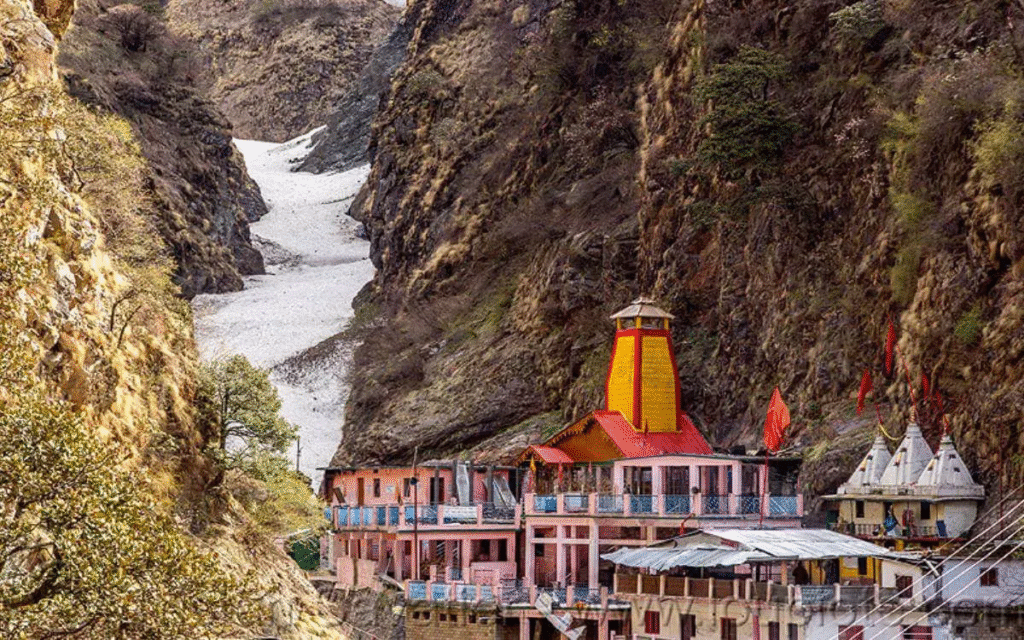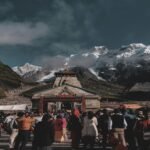
It was the ringing of the brass bells, tink-tink-tink, that became the soundtrack of my soul. That, and the scent—a sharp, dizzying mix of freezing air, pine sap, woodsmoke, and the heavy, sweet dhoop (incense) carried on the wind. Forget what the travel brochures show you; the real Yamunotri Yatra hits you right in the gut with pure, raw Himalayas.
I remember standing there, staring up the impossibly steep trail. This journey to the source of the River Yamuna—the very river that flows through Delhi and Agra—isn’t just a physical climb to 3,293 meters. It’s a steep, breathless, and totally essential climb into humility.
In the next few pages, I’ll tell you my version of the story: the myths that suddenly felt real, the treacherous but beautiful climb, the moment I almost cried at the temple, and the practical tips I wish someone had whispered to me beforehand. Get ready to hike, because this is where the real journey begins.
Myth: The Sister Who Cares (And Why You Need Her)
Before you worry about packing your hiking boots, you need to know why we’re here. The story of Maa Yamuna is one of the most comforting in Hindu history, and understanding it changed how I viewed the entire trip.
Yamuna is the daughter of Surya (the Sun God) and the twin sister of Yama (the God of Death). Yeah, that’s intense.
Because her brother is the ultimate decider of souls, Yamuna is seen as the compassionate intercessor. The belief that bathing in her sacred waters cleanses your deepest sins and, crucially, protects you from the pain of untimely death (Apamrityu) isn’t just a doctrine—it’s the deep, silent hope carried by every pilgrim.
I found myself reflecting on this the most: the Goddess who is eternally tied to life and death. It felt incredibly grounding. It wasn’t about avoiding death, but about living better now. The whole pilgrimage becomes less about ritual and more about self-reflection and asking for a bit of grace in a chaotic life.
And then there’s the beautiful paradox: the temple sits right next to those boiling hot springs (Surya Kund). Fire and Ice. The divine heat of the sun’s daughter, right next to the freezing Himalayan meltwater. It’s like the universe is saying, “Life is full of extremes, but harmony exists.” It deepened the meaning of every steep, cold step I took.
The Road Trip: Where My Phone Died and My Patience Was Tested
The logistics of reaching Yamunotri are not for the faint of heart. It’s a three-stage commitment, each phase shedding a layer of your modern life.
The Practical Grind
The Starting Blocks: I flew into Jolly Grant (Dehradun). You could also start from the railhead in Rishikesh, but either way, you’re looking at a serious road trip next.
The Long Drive: You spend a day twisting and turning through the mountains, usually stopping at Barkot. This stopover is essential. Not only for acclimatization but because driving the whole way in one go is a recipe for a monumental headache and car sickness. Barkot is a friendly, reliable town with good, clean GMVN (government-run) guesthouses.
The Base Camp: Janki Chatti: The asphalt finally gives up here. This bustling, crowded little hamlet is the last motorable point, and from here, it’s all legwork.
The 6 KM Trek: Putting Soul Over Speed
The final stretch from Janki Chatti to Yamunotri Temple is about 6 kilometers. Six kilometers might sound like a walk in the park, but it’s a non-stop, steep uphill climb. It tested my fitness—and my will—immediately.
Pace Yourself: I walked it in about 4 hours. Don’t rush. The path is stone, often wet, and crowded.
The trail itself is beautiful—steep cliffs on one side, dense forest and the roaring sound of the young Yamuna on the other. It’s a sensory detox, forcing you to focus only on the next step. If anyone who dosen’t want to focus on travel food and stay and just focus on the divine jouney they can contact any tour and trekking companies like The Mountain Trekker who takes care of everything thing from food to stay and ensures your save and comfortable journey.

Culture Check: The Magic of Woodsmoke and Bhajans
The magic of the Yamunotri Yatra isn’t just at the temple; it’s in the villages that sustain it.
Kharsali and the Quiet Life
As you move up the valley, you see these tiny, dark-wood villages like Kharsali (the winter home of the Goddess) and Hanuman Chatti. They are the definition of mountain simplicity. The traditional wooden architecture, designed to withstand crushing snow loads, gives everything a cozy, resilient feel.
One evening in Kharsali, I was sipping a cup of chai that tasted vaguely of ginger and cardamom, watching a group of locals gathering wood. They looked tough, weathered, and completely peaceful. They are the Garhwalis, the keepers of this land, and their hospitality is immediate and genuine. You feel like you’re stepping back in time to a life dictated entirely by the seasons, not by the stock market.
Fueling Yamunotri Yatra
Forget ordering anything fancy. Your body needs warmth and energy. The local Garhwali cuisine is your best friend: thick, satisfying Rajma Chawal (red beans and rice), and hearty dals made from local pulses like Gahat. It’s simple, nutritious, and served with a warmth that makes up for the lack of Michelin stars.
The complex sits right against the base of the Banderpooch peak. It’s not a huge temple, but the energy packed into this little area is immense.
The Pre-Temple Must-Dos
Divya Shila: First, you pay your respects at the Divya Shila, a revered rock pillar near the temple entrance. It’s the traditional spot to offer the first prayers, like signing in for your darshan.
Surya Kund: The Rice Ritual: This is pure magic. Next to the temple is the Surya Kund, a natural hot spring that is literally boiling. Pilgrims wrap small amounts of rice (or sometimes potatoes) in muslin cloth and drop them into the spring. It cooks in minutes! The steam rises into the icy air, creating a beautiful contrast. I took my cooked rice—my Sun-God-blessed prasad—with me. It felt like an ancient, primal ritual, fire meeting ice to nourish the body and soul.
The Darshan
Inside the Yamunotri Temple, the main deity, Goddess Yamuna, is represented by a stunning black marble idol. You’re packed in tight with your fellow pilgrims, bells ringing, priests chanting in rapid Sanskrit. It’s noisy, chaotic, and intensely moving.
Standing before the Goddess, I felt a deep rush of humility. I hadn’t made it up here on my own strength. It was the driver, the pony wallahs, the chai lady, and the collective hope of everyone on the path. The spiritual essence here is that the mountain has granted you permission to arrive. You have cleansed your body in the journey; now you cleanse your spirit.
I looked out past the temple, and saw the actual stream of the Yamuna, still a roaring, youthful waterfall, tumbling down the rocks. I was at the source. It was a profound, quiet feeling of having completed what was asked of me.

Beyond the Temple: Finding Quiet in the Cold
For those with a few extra days and a craving for absolute solitude, the Yamunotri region offers profound escapes.
Saptarishi Kund: For the Hardcore Seekers
This is the hidden gem, the “true” glacial source of the Yamuna, located much higher up. I didn’t attempt this, and honestly, unless you are a seasoned, prepared high-altitude trekker with a guide, I don’t recommend it. It’s remote, unforgiving, and often snow-bound. But the idea of it—the pristine, untouched glacial lake where the seven great sages are said to have meditated—is deeply inspiring. It’s the ultimate spiritual destination for those who feel the temple is still too busy.
The Winter Retreat: Kharsali
Visiting Kharsali is an easy, calming side trip. This is where the Goddess’s idol rests during the six months the temple is closed. It feels less like a pilgrimage spot and more like a quiet village retreat, dominated by the exquisite Shani Dev Temple. It’s the perfect place to slow down, watch the locals, and soak up the traditional mountain life without the pilgrim rush. This is where you find the true inner calm after the intensity of the trek.
Essential Travel Tips For Yamunotri Yatra: Advice from the Trail
You can’t control the mountains, but you can control your preparation. Learn from my journey!
What to Pack/Do Why It Matters (My Personal Take)
Layered Clothing The weather changes in minutes. You’ll sweat climbing the Janki Chatti trek, then freeze once you stop. Thermals and a waterproof jacket are non-negotiable.
Trekking Shoes Don’t skimp here. The path is stone, wet, and shared with ponies. You need non-slip, deep-tread soles. Trust me, I almost slipped three times.
Pace Yourself (Crucial!) Take a rest day in Barkot. This is how you avoid altitude sickness. Walk slower than you think you need to. Headaches are not normal—they are a warning.
Cash is King ATMs are sparse and often out of order. Digital payments barely work. Carry enough cash for ponies, meals, and emergencies.
Go Post-Monsoon September and October are divine. The sky is clearer, the crowds are thinner, and the mountain air is at its crispest. Avoid the July/August landslides.

Closing Thoughts On Yamunotri Yatra: Where Every Step Is a Prayer
I completed Yamunotri Yatra with sore legs but a quiet mind. The Yamunotri Yatra is the perfect metaphor for life’s biggest lessons: you have to endure a difficult, uphill climb to reach a point of spiritual clarity. You can’t cheat the effort.
The Yamuna River, starting as that furious, cold trickle, and growing into a life-giving giant, taught me that purity is persistence. It’s the constant, relentless flow forward.
If you are craving an adventure that cleanses your soul, challenges your body, and gives you a deep, visceral connection to something ancient and pure, then the Himalayas are calling you to the first Dham. Go and make the effort. You won’t just find the source of a river; you’ll find a new source of strength within yourself.
At Yamunotri, every step feels like a prayer, and every breath echoes with the purity of the Himalayas.
If you loved reading about this blog you might also like Gangotri yatra blog.





Leave a Reply